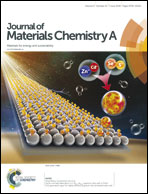Promoting perovskite crystal growth to achieve highly efficient and stable solar cells by introducing acetamide as an additive†
Abstract
To date, perovskite solar cells (PSCs) have achieved superior photovoltaic performance with a high power conversion efficiency (PCE) of over 22%. However, there are very few devices which have a high PCE and high stability simultaneously. In this study, we fabricated PSCs made from (FAPbI3)0.85(MAPbBr3)0.15 using the non-volatile Lewis base acetamide (CH3CONH2) as an additive. Compared to a reference device, the device containing 5 mg mL−1 CH3CONH2 displayed a markedly improved PCE of 19.01% and less hysteresis, due to its high-quality film with a better crystal structure, evidently larger grain size and greater thickness. In addition, the device with CH3CONH2 exhibited better humidity and heat stability. The unsealed device could maintain about 70% and 50% of its starting PCE under around 50% and 80% relative humidity (RH) for 1000 h and 700 h, respectively. Meanwhile, the unsealed device with CH3CONH2 could retain about 80% and 60% of its starting PCE at 60 °C and 85 °C for 200 h and 150 h, respectively. These results clearly show that using CH3CONH2 as an additive can promote crystal growth and enhance the grain size of perovskite thin films and introducing a suitable additive can realize the simultaneous improvement of the PCE and stability of PSCs.



 Please wait while we load your content...
Please wait while we load your content...